| CROSS-COUNTRY CHRONICLE
Catherine Ryan on Gloucester, MA in landmark Farm Security Administration/Office of War Information (FSA/OWI) documentary photographs. Part 1 Hey, Joey, Have a look at Gloucester from this important collection. First up—the Gordon Parks post. 1942. FOBs may recognize some of the faces, names, places. You recently featured the ‘American Gothic’Wallflowers, by this super artist on GMG which reminded me of the road less traveled within this historic collection of photographs archived at the Library of Congress and the New York Public Library. This post is Part 1 in a series on Gloucester images in this legendary FSA/OWI collection. If you are interested in the scope of any Gloucester material from this collection, we know that at least 4 of the FSA/OWI photographers came through Gloucester, MA. No surprise, each photographer took photo(s) of the Fisherman at the Wheel. They also show the impact of WWII. If you can id any of the Gloucesterpeople, please contact me. I’ve listed some known Gloucester names at the end of the post. In 1934 during the Great Depression, Fortune magazine dispatched Margaret Bourke-White to cover the Dust Bowl. She sent additional images to the New Masses and the Nation. In 1935, for one of its many New Deal programs, the US government sent photographers across the country on assignment. Initially their photographs were intended to illustrate the results of the country’s latest efforts to alleviate rural poverty. Ultimately, they created a legendary photographic record of 1935-1945. Here is a jaw-dropping list of established and future notables who Stryker hired for this incredible visual encyclopedia: Esther Bubley, John Collier, Walker Evans, Dorothea Lange, Russell Lee, GordonParks, Marion Post Walcott, Louise Rosskam, Arthur Rothstein, Ben Shahn, George Stoney, John Vachon, and Marion Post Walcott. Stryker also primed an extensive “orbit” of contacts and influence. What is the FSA/OWI collection? (See explanation at the end of this post.) |
| American Photographer GORDON PARKS (1912-2006)
119 FSA/OWI photos for Gloucester, MA, May and June 1942
|
| In 2012, the International Center of Photography in New York commemorated the centennial of GordonPark’s birth with a year-long installation featuring 50+ photos (one of the Gloucester ones was in there). |
| Gordon Parks believed the positive reaction he received for some of his early fashion images was his first break (Melva Louis, Joe Louis’ first wife). This support pushed him to set up a photography portrait business in Chicago. He also photographed out in the streets. He was inspired by Norman Alley’s bombing of Panay coverage (1937). FSA/OWI photographer Jack Delano saw his work and urged him to try to enter Stryker’s program via a Rosenwald fellowship. He was 30 when he was brought on board and thrilled to join this famous group. He was the first African American to be hired by Stryker. He worked there less than two years as the program ended. He followed Stryker into a commercial job. Gordon Parks was a man of dazzling talents. His FSA/OWI photos hint at his many future creative pursuits. This work though was rarely seen. |
| You can see Parks skilled portrait photographs: leaders of faith, presidents of universities, people working and at home, such as Mrs. Isabell Lopez of Gloucester, mother of 6 holding her grandchild. |
| There are celebrity portraits: Paul Robeson, Mrs. Roosevelt with Wang Yung, Langston Hughes, and Richard Wright. Portraits and fashion were his bread and butter back in Chicago, before landing a post with this famous group.
|
| You can see Gordon Parks the social activist. From left to right: pushing for safer streets, e.g. protection for our kids (devastating streetcar accidents); Jim Crow train FLA; his famous ‘American Gothic’ portrait of Ella Watson who cleaned nights at the FSA government office in Washington, DC. Parks thought this image heavy handed; there is essentially what amounts to a still-photo mini documentary of Ella Watson at home, with her family and at work for more of her story.
Gordon Parks did 1 Gloucester protection/safety photograph, a dangerous crossing.
|
| You can see Gordon Parks the fashion photographer. Welder on the left is Rosie the Riveter style; and on the right Mrs. Lopez’s daughter, at home Gloucester, MA. The still-lives are Duke Ellington’s colorful ties and one of Jay Thorpe’s Four Freedoms textiles.
|
| You can see Gordon Parks the humanist: ordinary big moments with Girls Scouts at a memorial service,Gloucester, MA; New York state camps where kids and staff are made up of diverse backgrounds; AldenCaptain and crew are relaxed, easy company together while in New York. |
| You can glimpse Gordon Parks the musician/composer through the arts he selected to cover while on assignment for the FSA/OWI. Marian Anderson’s broadcast at a mural dedication commemorating her Lincoln Memorial concert. Duke Ellington and the Orchestra at the Hurricane Club Ballroom, in New York City, April 1943.
|
| There are also photos of Ellington trying to hear his band; Betty Rocha singing with the Orchestra; and individual portraits of musicians Rex Stewart, Ray Nance, Juan Tizol, Sunny Greer, and Johnny Hodges. The caption for Hodges includes the song title played during his portrait session, “Don’t Get around Much Anymore.” Parks also photographed the Club staff and customers
|
| You can see Gordon Parks the movie Director. Some of his FSA/OWI work looks ready for neorealist cinema. (Rome, Open City global 1946.) The image on the left features generations of the women of the Machado/Lopez family. The boys at the Leonard Craske Fisherman at the Wheel memorial are not identified (one close up).
The center mirror image reminds me of film school students and their emulation of Citizen Kane (1941) and other camera tricks. The image in the mirror is from one of Parks early assignments with the FSA. Mirrors and reflections tend toward symbolism anyhow. Parks is there photographing HowardUniversity. It feels like he snapped this on the sly when seen with the other ‘dailies’. It’s Thanksgiving Dinner and President of Howard University, Mordicai Johnson, is being served by an African American. |
| There’s scene shots: movie-scale streets and crowd shots teeming in NYC or downtown Gloucester. Gordon Parks filed 50+ pictures for the Nature of the Enemy show, the second exhibition of the “This is Our War” series of outdoor installations on the promenade of RockefellerCenter, May – July, 1943. ForGloucester, it’s Memorial Day services. |
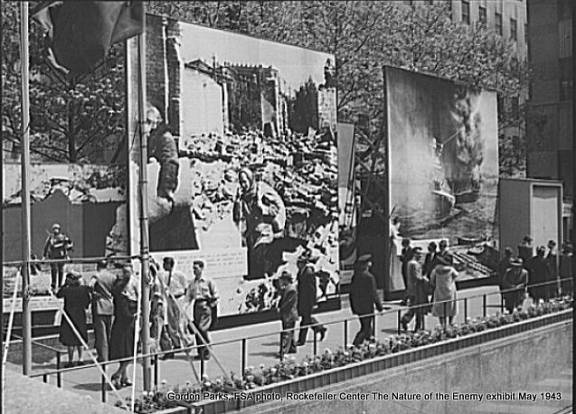
|
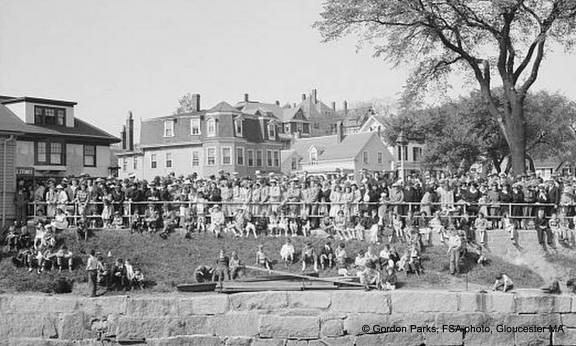
|
| You can see GordonParks the photo journalist and author through the captions he wrote. For the Gloucester FSA/OWI photos there is a complete photo-journalism expose where he tracks a journey from sea to plate that begins in Gloucester and ends up in New York. The collaboration of GMG Gloucester photographers Kathy Chapman and Marty Luster Fish on Fridays series is such an interesting connection. |
| “The mackerel caught off the Gloucester coast ends up on the table of Mrs. Rose Carrendeno, NYC, for Friday’s supper. She prepared and served the fish that she bought earlier that day from Joseph DeMartino’s shop who buys his fish each morning from the Fulton Fish Market. She and her husband have three sons in the armed forces…She stops to chat with Mrs. DeMartino about the ration problems while Joseph DeMartino cleans the mackerel she has purchased.
“Fishermen’s families often make trips down from New England towns to be in New York when the ship arrives. The fishermen consider that nothing is too good for their families.” |
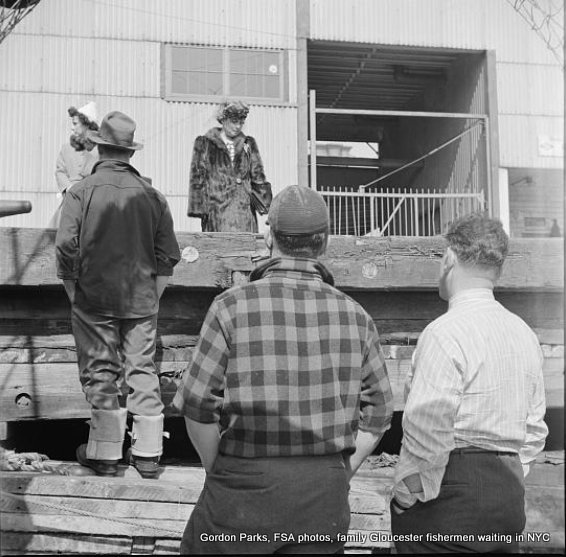 |
 |
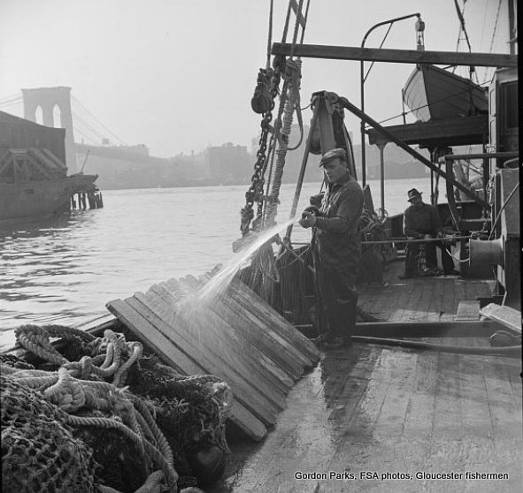 |
 |
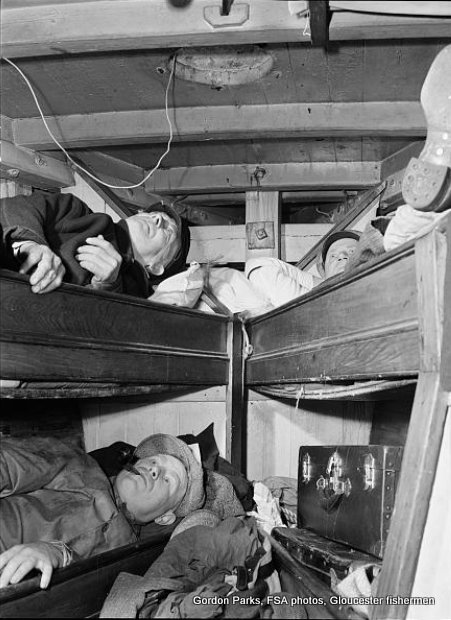 |
 |
 |
| Close up of Mrs. Carrendeno’s ingredients for FOB
|
| What is the FSA/OWI collection?
President Franklin Delano Roosevelt selected a social economist from ColumbiaUniversity, Rexford Tugwell, as Undersecretary of Agriculture in 1934. One of Tugwell’s policy directives included new analysis of assistance for dislocated farmers. He enticed a protégé, economist Roy E. Stryker, to come with him toWashington to direct the Resettlement Administration’s Historical Section. Stryker was the perfect hire, and successfully eked out the program from 1935-1942. He believed photography would be the key tool. At Columbia, he was a master at amassing visuals and presentations to illustrate economic topics. While a Professor, he insisted his students get out and survey what’s around them, walk “the field”, “see.” The FSA/OWI photographers documented daily life, the effects of the Depression and WWII across the country, the problems our country was facing, Main Streets, landmarks, portraits, workers, communities and families. There is great range of intention, style, subject and theme across the collection. Some of the FSA/OWI photographs received nearly instantaneous and phenomenal fame. The reputation of this work was so respected, so known, that employment in this program would later open doors to grants and commercial jobs, and for several artists, launched long illustrious careers. Stryker promoted and protected these artists and the work as the best art dealers do: fleshing out projects, orchestrating exhibits, doggedly getting their work out there to be seen, and placing it in print– whether for church pamphlets or major media publications, or into galleries and collections. When he moved back to the private sector, he hired them. Unlike the art created for some other WPA-era agencies that was lost or destroyed, Stryker and his team had the foresight to try to protect all of it for perpetuity. At the closure of this program, he sought approval from President Roosevelt to transfer the master collection to the Library of Congress (nearly 280,000 items) as part of our National Archives, which was granted. Throughout the program he shipped boxes of prints to the New York Public Library (41,000 items) so that there would be an additional repository if a safe haven in Washington, DC, did not come together. As a result there have been two outstanding collections to study and access. (Other collections and institutions have smaller holdings of vintage prints.) The Library of Congress remains the primary source for use and research. Through the 1950s, one could check out vintage prints along with books at the NYPL. As with many collections, the same images were often requested over and over. The Library of Congress digitized their FSA/OWI collection in the late 1980s and has been deeply committed to ongoing technological updates. In 2005 the NYPL determined that 1000 photos in their collection were actually “new” discoveries; they put these on line in 2012. There are over 270,000 items in the Library of Congress Farm Security Administration/Office of War Information (FSA/OWI) archives, all digitized. IF you haven’t seen these images in person, look for exhibitions of the true vintage prints. There are many iconic photographs. Some capture a gap between ideals and reality. They have been studied, published and featured many times over. As the Gloucester images show, the collection is not solely images of farmers, rural problems, and Western states. -Catherine Ryan / – all photos Library of Congress, FSA/OWI black and white photography collection |
| To search Gordon Parks FSA/OWI photographs for Gloucester, type in key words
Fishermen on the ALDEN
Gordon Pew Fisheries worker, Joseph Lopez and his family
Search for Gloucester landmarks. There are two or three photos in Rockport: the Pewter Shop and the owner Mrs. Whitney |
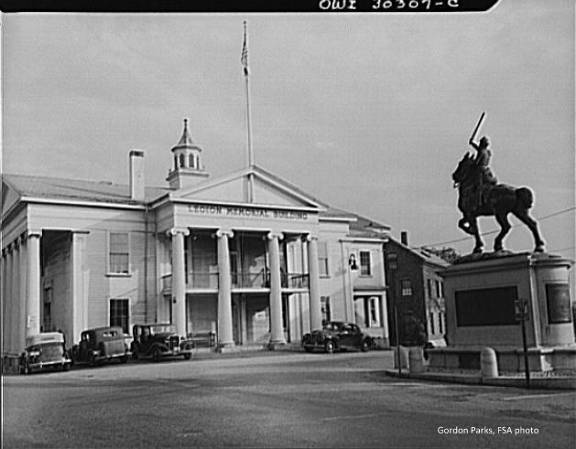 |
- Comment
- Reblog
-
Subscribe
Subscribed
Already have a WordPress.com account? Log in now.

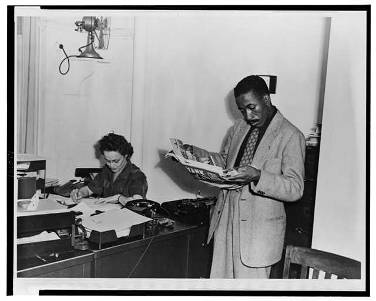
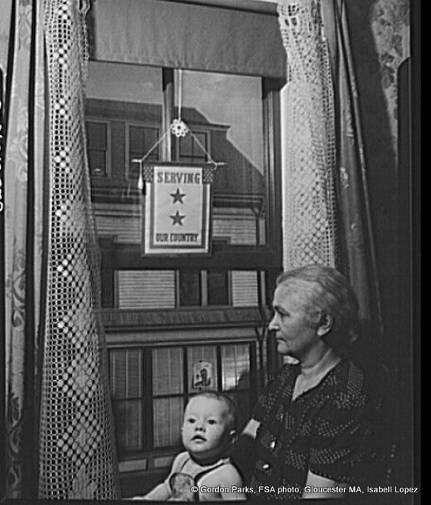
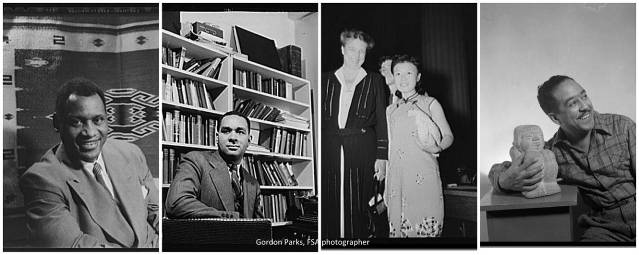

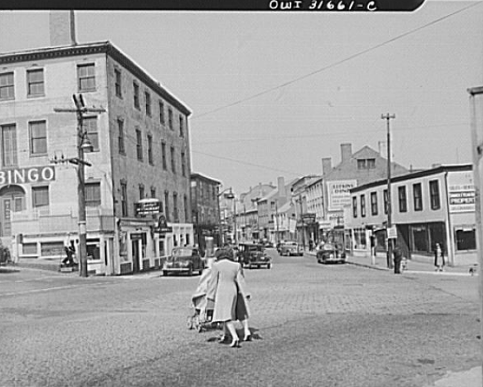

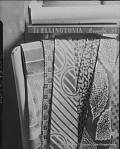



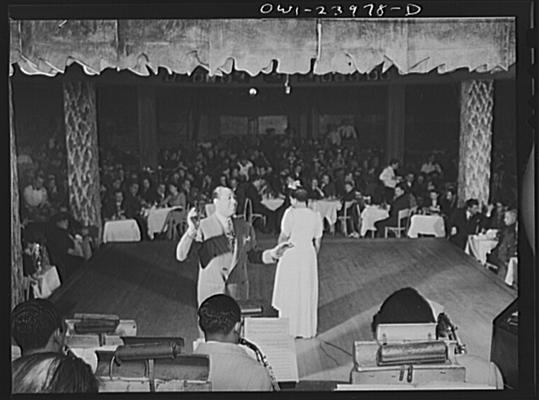
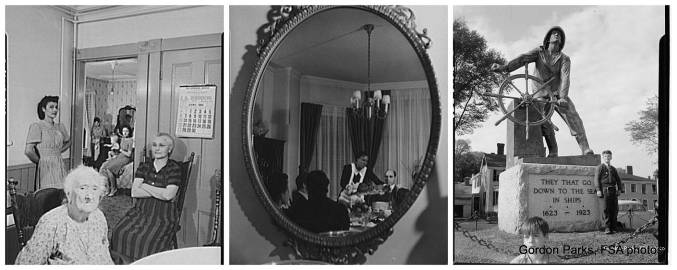
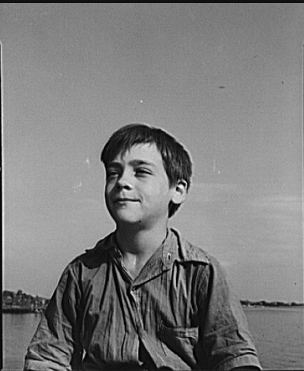

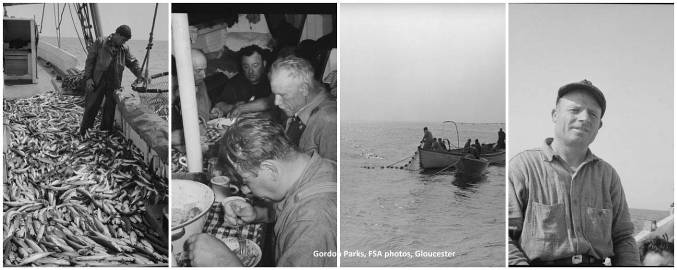


Catherine,
Thanks so much for bringing us part of this important and outstanding collection. For those of us whose cameras are permanently affixed to our hands these photos remind us of the importance of documenting our own times for future generations. We cannot help but be inspired by those who have come before.
Again, thanks for this effort.
LikeLike
GMG photographers inspire. Thanks, Marty.
LikeLike
These are great! The University of Chicago Laboratory Schools (from which my son graduated) announced this week that they are naming their new arts building for Gordon Parks:
http://www.uchicago.edu/features/25_million_grant_to_support_laboratory_schools_arts_hall/
LikeLike
Thank you Sem Sutter. So great to have that in Chicago! –and with an endowment from George Lucas and Mellody Hobson! His career has eclipsed others. His archives are at Suny Purchase http://www.gordonparksfoundation.org/ and dealer Howard Greenberg represents the estate.
LikeLike
Thanks again for this interesting story and the great photos.
LikeLike
I read all Gordon Park’s books. I had no idea he photographed Gloucester. He was a great man.
LikeLike
Agree–wish I interviewed him. There are many reasons why the Gloucester images–all his FSA/OWI images– aren’t as known, but they have been out there. Thanks for looking!
LikeLike
That’s pretty awesome
LikeLike
Fantastic and very informative post ~ thanks ^_^
LikeLike
Thanks Kim. Gordon Parks’ photos of NYC and Gloucester are so Marty, who hails from both ports.
LikeLike
Hi Fred!nice to see your avatar.
yes there’s a connection there with the Gloucester images. i see it, too.
LikeLike
Fred – glad to see you back on-board Dave & Kim
LikeLike
Fabulous. Thank you!!!
LikeLike
Fantastic. what’s next? Love the Robeson in front of a Mexican serape and Richard Wright in front of a Mesoamerican head.In the same row no less and placed under the odd geometrics of lace curtains in Gloucester.
LikeLike
Hi Lise! He’s good with textiles and patterns. Wright with books / Hughes with sculpture
LikeLike
Thank you for researching and posting this material Catherine! This is very important documentation of a time past. I especially love the lobsterman portrait.
LikeLike
Hi Kathy. I like that one, too, and wonder who he is. I grabbed some examples for broad sweeps, but you can find others you like as much or more than the lobsterman. Am curious what you like with that one, as artist on artist?
LikeLike
That photograph tells a story and is formally exquisite. I think it is a successful photograph because of his proud expression, the sharpness of the lens, the beautiful natural light on his face, the depth of field setting the background off in the distance and of course the size of that claw! I will check out the others. Those grants produced important documents and excellent work.
LikeLike
Thanks, Kathy. I have been lucky to work with artists–it is a delight & privilege to hear artists discuss art.
LikeLike
Wow. I’m in here searching and I can’t get out. A quarter of a million photos. Thanks for culling out some amazing ones.
LikeLike
Great–I’m glad you’re getting lost. One point of entry can be as simple as searching for places that have personal meaning. I know the collection well, having worked with 30+ WPA era artists (though no FSA) and directed/curated many exhibits. The size of these archives means that there are a lot of ways to contribute, so please continue to explore.
LikeLike
These are great thank you!
LikeLike
I needed a little chunk of time to read all Catherine, and to follow links. Thank you for bringing us this series. Beautiful to see and read about Gordon Parks, inspirational, and I love your commentary always. Thank you.
In reading more about Parks–readers may want to know he also directed “Shaft.”
LikeLike
Right. Where he came from, what he did, remarkable that any person could do so much so well! ’12 Years a Slave’ he covered back in 1984 in a TV movie “Solomon Northup’s Odyssey”.
LikeLike
I have been asked about the Man at the Wheel as the Gordon Parks photo has an open vista. The wrap-around cenotaph was added in 2000. – catherine
LikeLike
Gordon Parks photos LOPES vs Lopez.
Gloucester residents, families: searching the archives for Lopez will help find the photos in that collection and where they’ve been shown and discussed. Lopez will always be part of the ID for these images. However, for helping with stories and their family roots in Gloucester the family name is LOPES.
Joseph Perry Lopes (1877-1969) and spouse, Isabell C. (Machado) Lopes(1888-1976). *Isabell was from Pico, Azores. In 1942, they resided at 332 Main Street. They had six children: son George James Lopes (b. Feb 9, 1923-d.1994), spouse Marie C.; daughter Irene Lopes, deceased; son Manuel P. Lopes, deceased; daughter Dorothy E Lopes, deceased, spouse Macalo Vagos; son Joseph Lopes, Jr, (b. August 30, 1912- d.May 21, 2011), Gloucester resident, spouse Simone F. (Danjou) Lopes, and daughters Simone Lopes and Lorraine Rocha; and son John Lopes.
-catherine
LikeLike
There were two Dorothy Lopes 1919-1919, her sister and name sake Dorothy E. Lopes was born 1920, she is the sweetest most loving person I know and her smile warms my heart, she is my Aunt.
LikeLiked by 1 person